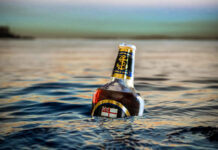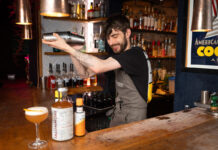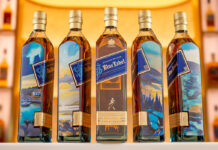Jim Beveridge and Ervin Trykowski share a similar passion for Scotch

ON the surface, you couldn’t ask for two more different characters than Jim Beveridge and Ervin Trykowski.
One, the quiet-spoken Johnnie Walker master blender with four decades of whisky-making experience under his belt. The other, the young global whisky ambassador as likely to be found behind the decks as behind the bar.
Yet when SLTN caught up with both men at the recent Diageo World Class global final it was obvious that – in addition to working for the same company – they share at least one other thing in common: they both love whisky.
Heading a team of a dozen blenders, Beveridge – who last month received an OBE for services to whisky – is the man ultimately responsible for maintaining the quality and consistency of the Johnnie Walker range.
That in itself is no mean feat.
As well as the core range of Red, Black, Green, Gold and Blue labels, there are various John Walker & Sons super-premium bottlings and a wide range of limited editions.
On top of that there’s the unenviable task of speaking to the media.
But even after 40 years, it’s clear Beveridge is passionate about the job.
“It’s such an exciting brand, and the thing that really gets me up in the morning is we’re getting the opportunity to create different expressions,” he said.
“Different takes on what whisky flavours can be like. And Johnnie Walker’s given us the freedom to do that.
“The differences in flavour are quite wide and broad. So as a blender it’s a great place to be.”

The Johnnie Walker range isn’t all that’s changed over the decades, of course, and Beveridge has been well-placed to see how Scotch – and attitudes towards it – have evolved.
He reckoned the way whisky companies talk about their product, and in particular the range of flavours present in it, has helped to grow the knowledge base across the country. As that has happened the knowledge of consumers has grown exponentially.
And the more they know, the more they want to know.
“We’ve spent quite a lot of time talking about whiskies and getting consumers to understand them, and I think that knowledge is important to consumers,” said Beveridge.
“That conversation about the whisky – what’s behind it, what makes it what it is, helping understand the flavours – that’s part of the journey, definitely.”
And of course, the way the whisky is served is hugely important – and another aspect of the industry that has changed over time.
Discussing the different ways whisky is now served – from traditional ‘neat with some water on the side’ presentations to mixers like ginger ale through to cocktails – Beveridge said bartenders have become “almost like part of the blending team”.
“And I think that’s great,” he said.
“Because it’s great to be able to enjoy Johnnie Walker in all these different ways.”
Enter Trykowski.
A big part of the bartender-turned-brand ambassador’s job is encouraging people to think differently about whisky – particularly about how it is served.
And when SLTN spoke to him he wasn’t taking any prisoners.
“Historically the problem is – and this is to a degree how everyone still does it – they talk about malt whisky straight,” he said.
“And then they go ‘and by the way, it’s really good in an Old Fashioned’.
“By the way’s not good enough. It should never be by the way. You should start with the suggestion. You should let them build it themselves and show them how to do it.
“We talk about Scotch whisky as being the most versatile spirit in the world.
“Stop talking about it and start showing people.”
And the fault doesn’t lie solely with bartenders, said Trykowski.
He said that, although things are changing, too much emphasis has been placed on drinking whisky neat by the producers themselves.
He said: “Historically when we start whisky presentations we say things like ‘does anyone not drink whisky?’
“Someone puts their hand up and then we bash them with 60 whiskies.
“What do you think they’re going to think? Do you think they’re going to go to their local shop and buy a bottle of single malt? Why would they?”
Trykowski is doing his part to change this by encouraging Diageo brand ambassadors to start every whisky tasting with a highball, a serve he said has “amazing bridging power between the whisky expert and the whisky newcomer”.
“When you add soda water it’s exactly the same as people putting a touch of water in their whisky,” he said.
“By dropping the intensity you up the complexity. It’s just an ABV thing. People don’t drink [alcohol] at 40% ABV; 90% of the public will drink things between 5% and 12% ABV. So why not with single malt?”
Perhaps more controversial for whisky purists has been Diageo’s promotion of the Smokey Cokey – pairing a heavily-peated malt such as the company’s Lagavulin or Caol Ila with Coca-Cola.
Fortunately, the serve has received endorsements from a number of people in the industry, including whisky writer Dave Broom.
“Dave Broom has done us a massive favour by writing down in print that Lagavulin and Coke is amazing,” said Trykowski.
“It didn’t open the door, it kicked through it.
“The world drinks whisky and Coke. That’s how people discover whisky.
“Usually it’s bourbon or Tennessee whiskey. But if you put some thought into it, and you realise Coke is a big, strong, rich, robust flavour full of nutty notes. If you break down the Coke and match it to the whisky it’s amazing.”
Although he said there’s still work to be done, Trykowski reckoned progress is being made in encouraging people on both sides of the bar to be more open-minded about whisky.
Ultimately, he said, it’s about “offering suggestions, not barriers”.



















